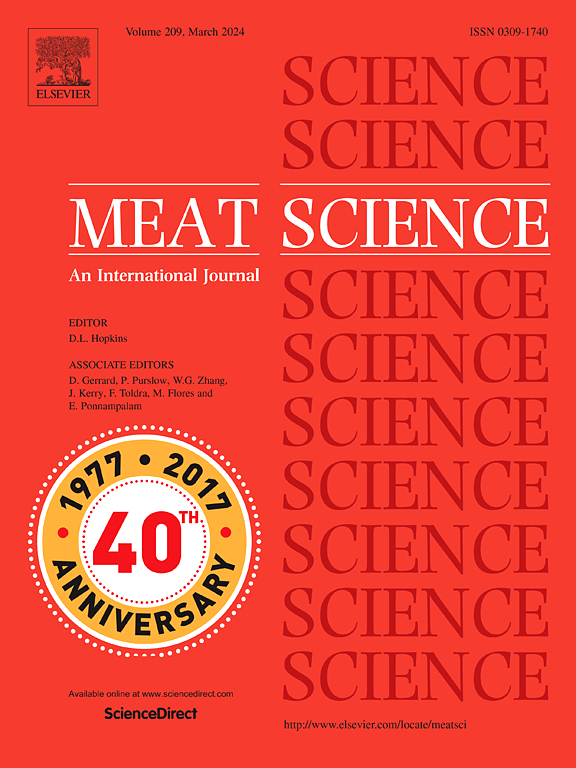Meat tenderness in Australian lamb: Data editing, environmental variation and their effects in genetic parameter estimation
IF 7.1
1区 农林科学
Q1 Agricultural and Biological Sciences
引用次数: 0
Abstract
Breeding for meat quality increases the value of lambs and requires reliable genetic parameters to achieve balanced genetic progress. Meat tenderness, accomplished by selecting for lower shear force, is an important eating quality trait because of its relationship with consumer satisfaction. Factors influencing shear force, include the pH and temperature decline post-mortem which can contribute towards higher shear force values and increased variation across contemporary groups. This study explored if genetic parameters for shear force change when post slaughter covariates and heterogeneous variance are corrected for, using data from 32,223 animals from different sheep breeds. Results showed that removing extreme individuals and contemporary groups with high mean shear force values reduced residual variance, followed by a smaller reduction in additive genetic variance and little effect on heritability. Results show that edited data performed better at predicting progeny performance and reduced potential bias introduced in the genetic evaluation due to data quality. The effect of including post-slaughter covariates in the genetic analysis was tested by estimating different model predictability through regression of estimated breeding values against offspring performance, showing that the model including hot carcass weight performed better followed by the one including both carcass weight and C-site fat depth. Our results highlight that historic and current in-plant recording practices do not provide the capacity to account for non-genetic factors associated with abattoir environment that might be impacting the ability to accurately calculate shear force breeding values. In that sense, genetic evaluation can be improved by applying more rigorous data editing.
澳大利亚羊肉的肉质细嫩度:数据编辑、环境变化及其对遗传参数估计的影响。
肉质育种提高了羔羊的价值,需要可靠的遗传参数来实现均衡的遗传进展。通过选择较低剪切力实现的肉质嫩度是一个重要的食用品质性状,因为它与消费者满意度有关。影响剪切力的因素包括死后 pH 值和温度的下降,这可能会导致剪切力值升高,并增加当代群体间的差异。本研究利用来自不同绵羊品种的 32,223 头绵羊的数据,探讨了在校正宰后协变量和异质性变异后,剪切力遗传参数是否会发生变化。结果表明,剔除平均剪切力值高的极端个体和当代群体可减少残差,随后加性遗传变异的减少幅度较小,对遗传率的影响不大。结果表明,编辑后的数据在预测后代表现方面表现更好,并减少了遗传评估中因数据质量而产生的潜在偏差。在遗传分析中加入屠宰后协变量的效果是通过估计育种值与后代表现的回归估计不同的模型预测性来检验的,结果表明,加入热胴体重的模型表现更好,其次是加入胴体重和C部位脂肪深度的模型。我们的研究结果突出表明,历史上和当前的厂内记录方法无法考虑与屠宰场环境相关的非遗传因素,这些因素可能会影响准确计算剪切力育种值的能力。从这个意义上讲,基因评估可以通过应用更严格的数据编辑来改进。
本文章由计算机程序翻译,如有差异,请以英文原文为准。
求助全文
约1分钟内获得全文
求助全文
来源期刊

Meat Science
工程技术-食品科技
CiteScore
12.60
自引率
9.90%
发文量
282
审稿时长
60 days
期刊介绍:
The aim of Meat Science is to serve as a suitable platform for the dissemination of interdisciplinary and international knowledge on all factors influencing the properties of meat. While the journal primarily focuses on the flesh of mammals, contributions related to poultry will be considered if they enhance the overall understanding of the relationship between muscle nature and meat quality post mortem. Additionally, papers on large birds (e.g., emus, ostriches) as well as wild-captured mammals and crocodiles will be welcomed.
 求助内容:
求助内容: 应助结果提醒方式:
应助结果提醒方式:


